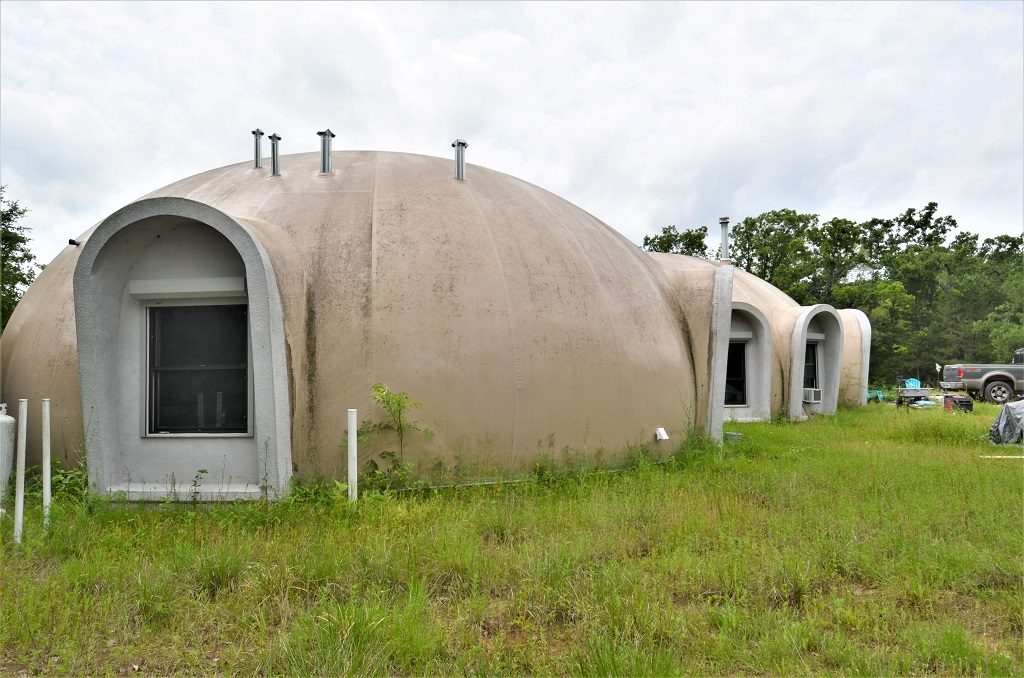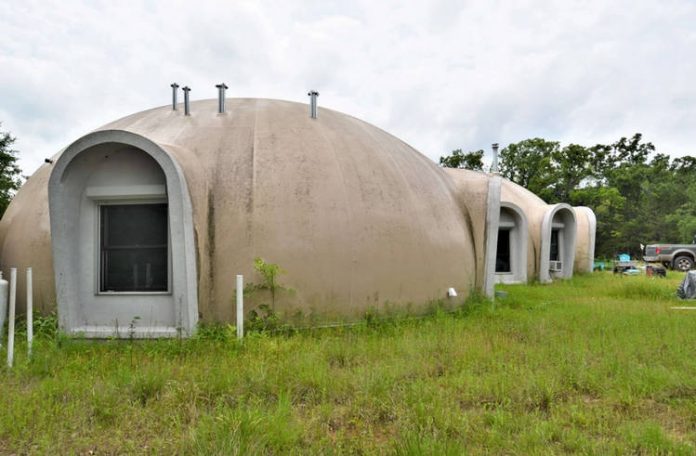We recently recapped our experience visiting the home of two of our customers, which happens to be a dome home. As architecture junkies, we were blown away by the engineering principle of a rounded domicile that is incredibly sturdy without needing any load-bearing walls on the inside.
But we thought that it might be helpful to give our readers a more in-depth guide to this unconventional style of home as many of you may not be familiar with it. You might be surprised to learn that a dome home’s looks aren’t the only thing that make it special.
What Is a Dome Home?
A dome home is a house, with doors and windows like any house, except in the shape of a sphere or rounded ellipsoid that incorporates some kind of shell framework. There are two main kinds of dome homes, distinguished by the type of shell they employ:
Geodesic Dome Homes
These structures are polyhedrons–at least in part–which means all or a portion of the outside face is a system of (typically) interconnected triangles. The first dome structure was a geodesic planetarium built in Germany after World War I. Geodesic homes were popularized in the U.S. by architect and author Buckminster Fuller, who appreciated their stability and efficiency.
Although quite sturdy, geodesic domes do run the risk of weakening at one of the many joints in the shell or succumbing to water or moisture entering through a seam. However, because their construction style enables geodesic homes to still have a roof and walls, many owners may be more attracted to them as less of a departure from a typical home.

A geodesic dome home in California.
Monolithic Dome Homes
These homes utilize a single thick layer of concrete and other materials for their shell. In other words, they are one-piece; monolithic means “one stone.” This uniform exterior makes them amazingly durable and airtight. They’re also resistant to bugs and rot thanks to their concrete exterior.
Visually, monolithic dome homes have a tendency to look somewhat monotonous from the outside. But there are notable exceptions to this, and the interior can be furnished and customized in a virtually limitless number of ways.

A monolithic dome home we recently visited in Texas.
More Reasons to Build a Dome Home
Obviously, a spherical house is not for everybody. The term “geodesic dome” has been in use in the U.S. since as far back as 1950, and in the ensuing decades dome living has always remained a fringe aspect of American domestic architecture.
Nevertheless, dome houses have always offered a handful of advantages over traditional homes that continue to draw customers today:
- They’re energy-efficient: A study completed in 2016 by dome-home maker Monolithic Constructors found the utility savings of a 50-foot, ellipsoid house in Virginia were more than $2,500 over five years, compared to the average house in the state (despite powering a two-car garage and pump-house). The house we visited was actually three connected domes totaling 3,200 square feet, and yet it can easily be powered with a small array of solar panels.
- They’re disaster-proof: If you’re like us and live in the flood-prone Houston area, a dome home should be a particularly enticing option because it is virtually indestructible when faced with extreme weather events. Monolithic dome homes have weathered earthquakes, Category 5 hurricanes, tornadoes, and fires. In fact, the entire structure of a dome house qualifies as a safe room with “near-absolute protection” by FEMA standards.
- They’re low-cost: As we mentioned, dome homes are great for lowering your utility bills. But they save money in materials, as well. A dome home’s shape means far less surface area than a typical home and can require as little as half or 25% the materials necessary to build it. In other words, the cost savings begin during construction and continue for the life of the home.
- They’re out-of-the-ordinary: Why have a statement chair when you could have a statement home? Today’s dome houses tell the world that you’re an independent, forward-thinker who knows beauty comes in all shapes and sizes.
How to Build a Dome Home
We touched on the building process for a monolithic dome house in our article on our dome home visit, but essentially the process goes like this:
- Pour the slab.
- Inflate an air form or membrane that’s attached to the foundation.
- Spray polyurethane foam onto the interior of the membrane. (If using a product like Aircrete that contains both cement and foam, you can skip this step.)
- Install steel rebar over the foam.
- After installing piping and wiring, spray several inches of concrete over the rebar.
- Plaster over the concrete and paint the interior, if desired.
- Spray another 3-4 inches of concrete on the exterior and paint, if desired.
For geodesic homes, a kit is the easiest and cheapest way to get one. Geodesic dome home kits are available from a number of different companies, with Timberline being arguably the best-known brand. Timberline’s hub-and-strut framework allows homeowners with no building experience to assemble the entire dome with just socket wrenches, hammers, and ladders (with scaffolding and a nail gun recommended). Without a kit, you’re looking at cutting a lot of triangles and doing a lot of math!
Monolithic dome homes are similarly DIY-friendly. DomeGaia, the maker of Aircrete, offers “eco-elegant” building workshops and handy tools like the Little Dragon foam generator on its website.
How Much Do Dome Homes Cost?
As far as the cost of dome homes, the short answer is that as with all homes, it varies. Monolithic Constructors prices their branded homes at $65 per square foot for the shell-and-floor-only package, and twice that for a finished dome home. On the other hand, you could build a small monolithic dome house as a permanent shelter for under $10,000 if you do it yourself. To use DomeGaia’s example, a 1,000-square-foot dome four inches thick costs about $4,000 in Aircrete.
Geodesic dome home prices shake out much the same way–it depends on what you have in mind. You could make a fine home in the geodesic style with the help of a kit for around $50,000, or you could opt for something in the seven figures.
Dome Home Drawbacks
For all their pros, dome houses do have some inherent cons that even modern advances in the building technology can’t overcome. On our visit to the Ginsbergs’ home we learned echoing makes privacy tough to come by, and we saw first-hand how hard it is to put things like cabinets and art in a house with curved walls. It’s difficult not to end up with quite a bit of unused space.
The distinctiveness of these types of homes can also be a drawback. Your average homeowner association may very well say no to having one in its jurisdiction. While kits can be an easy way to find parts, they restrict your design choices and can make finding replacements challenging.
Even getting financing or appraisals can be tricky for dome homes, as appraisers need to be able to compare with similar homes sold in the last year to determine a property value. And that can be a problem, as these homes have a tendency to sit on the market for extended periods until the right buyer comes along who’s fired up about trying a “new” way to live.

